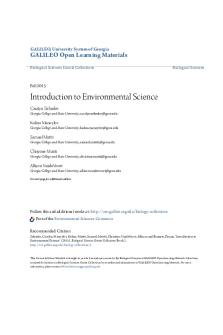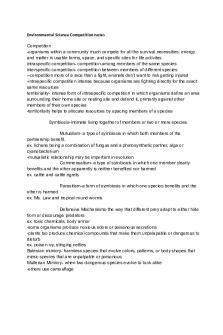GE 15 - Activity 8-9 - Environmental science PDF

| Title | GE 15 - Activity 8-9 - Environmental science |
|---|---|
| Author | irestrine ucab |
| Course | Environmental Communication |
| Institution | Illinois State University |
| Pages | 5 |
| File Size | 119.1 KB |
| File Type | |
| Total Downloads | 277 |
| Total Views | 649 |
Summary
LET’S CHECKActivity 5Biological Diversity 1. It refers to the variety of life forms, commonly expressed as thenumber of species or the number of genetic types in an area.Aesthetic 2. It refers to the beauty of nature, including the variety of life.Genetic Diversity 3. The total number of genetic cha...
Description
LET’S CHECK Activity 5
Biological Diversity 1. It refers to the variety of life forms, commonly expressed as the number of species or the number of genetic types in an area. Aesthetic 2. It refers to the beauty of nature, including the variety of life. Genetic Diversity 3. The total number of genetic characteristics of a species. Biological Evolution 4. The change in inherited characteristics of a populations from generation to generation. Genetic Drift 5. Refers to the changes in the frequency of a gene in a population due not to mutation, selection, or migration, but simply to chance. Endangered Species 6. Refers to species considered in imminent danger of extinction. Keystone Species 7. A species with major ecological functions and whose elimination would affect the other members of the biological community. Landscape Ecology 8. The science that examines the relationship between these spatial patterns and ecological processes. Flagship Species 9.A species that can motivate the public to preserve biodiversity and contribute to conservation. Indicator Species 10. Refers to species tied to specific biotic communities or successional stages or set of environmental conditions.
LET’S ANALYZE Activity 5
1. Discuss comprehensively what is species richness, species evenness, and species dominance.
•
The species richness is commonly utilized to assess the relative preservation standards of natural surroundings where it interfaces with the independence of the species, wherein geography with a few endemic animal groups that have raised protection esteem than those territories where species richness are comparable the species eveness depicts the general wealth of the various species in a zone, for instance, comparative bounty equals more equity. While a species dominance is a plant, creature or utilitarian gathering of various species most regularly or prominently found in a specific environment. It is commonly the most crowded species or includes the best biomass in an environment.
2. What
•
is
migration?
Can
migration
influence
biological
diversity?
The Migration has influenced natural resources for centuries and will continue to do so in the future, causing species and genetic loss, habitat fragmentation, loss of ecological connectedness, and disruption of evolutionary processes. Each migration is influenced by a complex and distinct collection of elements known as push and pull factors.
3. Identify and discuss the key processes of biological evolution.
•
Biological evolution has 4 parts, first one is Mutation when a mistake in DNA arises in an organism’s heritable cells, evolution through mutation happens because single – called asexual species, such as bacteria, reproduce via binary fission, the entire cell and its DNA is passed on to the next generation. Second one is Genetic Drift when the alleles that make it into the following generation in a population are
a random sample of the alleles in the current generations, evolution through genetic drift occurs. Third one is Natural selection evolution by natural selection occurs when certain genotypes produce more offspring than other genotypes in response to the environment. The last one is Migration because distinct populations are often subjected to different selective pressures and genetic drift, differing allele frequencies are expected. Individuals from one group migrate into a different population, bringing with them their differing allele frequencies. 4. Enumerate at least three (3) threats to biodiversity and discuss comprehensively.
•
Threats to biodiversity include:
1. Pollution: it prisons the population of the organisms which can cause acid rain and affect streams pollution is considered as the major cause of mortality for many species of wildlife. 2. Overpopulation: the increasing number of Population is considered a threat to biodiversity because it decreases the consumption of the species and this will impact wild species. 3. Overharvesting: causes the extinction of many species it is considered to be the primary driver of biodiversity loss. It also leads to overpopulation due to having more consumption and will reduce the efficiency of the resources.
IN A NUTSHELL Activity 5
1. Biodiversity is essential in almost every element of our life. We value biodiversity for a variety of reasons, some of which are utilitarian and others which are intrinsic.
2. Overpopulation is linked to a variety of detrimental environmental and economic consequences, including over-farming, deforestation, and water pollution, as well as eutrophication and global warming. While many great measures are being done to improve human sustainability on our planet. 3. Polluted air is causing a health emergency, with children being the most vulnerable. While the corporation will be well on its road to achieving environmental sustainability once pollution avoidance methods are integrated throughout the industrial process. 4. Overharvesting not only endangers the resource being collected, but it can also have a direct impact on humans, such as reducing the biodiversity needed for medical resources.
REFERENCES: •
Ayala, F. J. (1978). The mechanisms of evolution. Scientific American, 239(3), 5669.
•
Hurford, J. R. (1989). Biological evolution of the Saussurean sign as a component of the language acquisition device. Lingua, 77(2), 187-222.
•
Marten. G.G. 2008. Human Ecology: Basic Concepts for Sustainable Development.
•
Earthscan, USA.
•
https://nph.onlinelibrary.wiley.com/doi/10.1111/nph.15789#:~:text=Dominant%20 species%3A%20Species%20that%20have,in%20their%20range%20(limited).
•
Species
abundance.
(202,
October
19).
Encyclopedia
Britannica.
https://www.britannica.com/science/speciesabundance#:~:text=Species%20abundance%20is%20the%20number,but%20diff er%20in%20relative%20abundance •
What is species richness? + example. (2017, March 21). Socratic.org. https://socratic.org/questions/what-is-species-richness....
Similar Free PDFs

Environmental Science
- 16 Pages

Environmental Science Module 1
- 4 Pages

Environmental Science and Engineering
- 109 Pages

Environmental Science Midterm Review
- 17 Pages

Environmental Science Questions
- 52 Pages

Environmental Science Review Sheet
- 19 Pages

Environmental Science Lecture notes
- 25 Pages

Environmental Science English Only
- 10 Pages
Popular Institutions
- Tinajero National High School - Annex
- Politeknik Caltex Riau
- Yokohama City University
- SGT University
- University of Al-Qadisiyah
- Divine Word College of Vigan
- Techniek College Rotterdam
- Universidade de Santiago
- Universiti Teknologi MARA Cawangan Johor Kampus Pasir Gudang
- Poltekkes Kemenkes Yogyakarta
- Baguio City National High School
- Colegio san marcos
- preparatoria uno
- Centro de Bachillerato Tecnológico Industrial y de Servicios No. 107
- Dalian Maritime University
- Quang Trung Secondary School
- Colegio Tecnológico en Informática
- Corporación Regional de Educación Superior
- Grupo CEDVA
- Dar Al Uloom University
- Centro de Estudios Preuniversitarios de la Universidad Nacional de Ingeniería
- 上智大学
- Aakash International School, Nuna Majara
- San Felipe Neri Catholic School
- Kang Chiao International School - New Taipei City
- Misamis Occidental National High School
- Institución Educativa Escuela Normal Juan Ladrilleros
- Kolehiyo ng Pantukan
- Batanes State College
- Instituto Continental
- Sekolah Menengah Kejuruan Kesehatan Kaltara (Tarakan)
- Colegio de La Inmaculada Concepcion - Cebu







